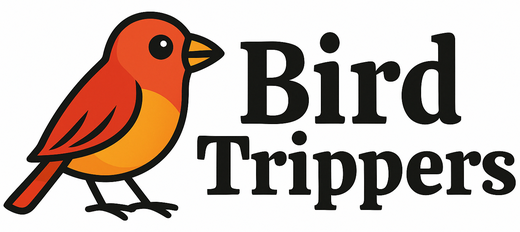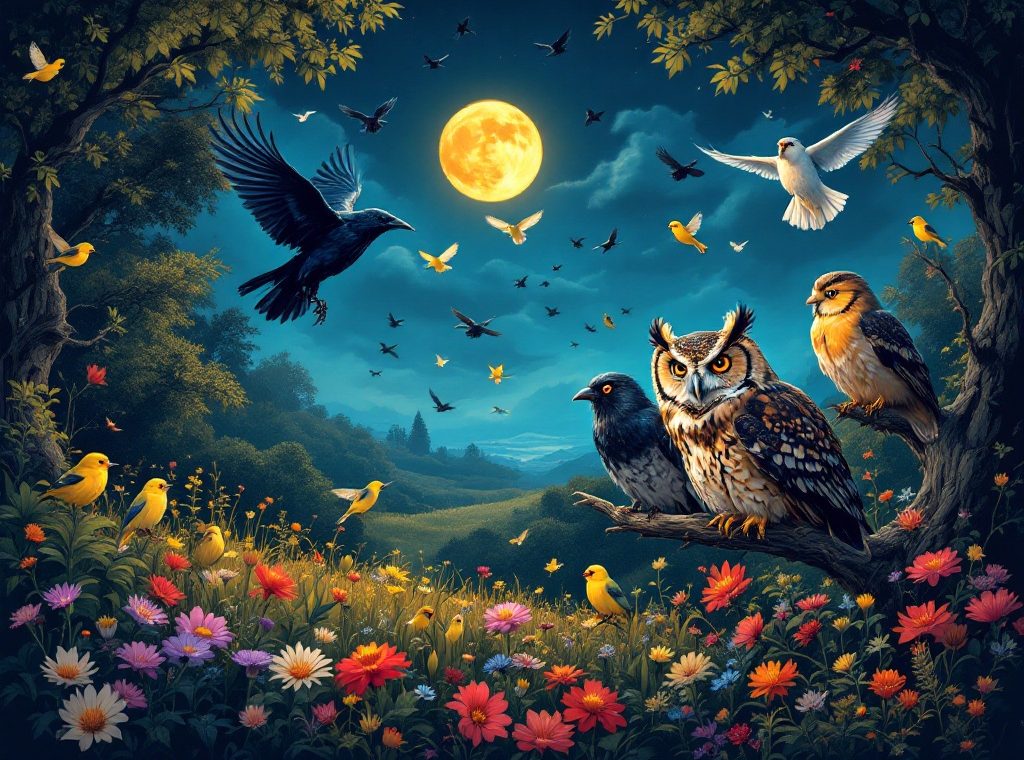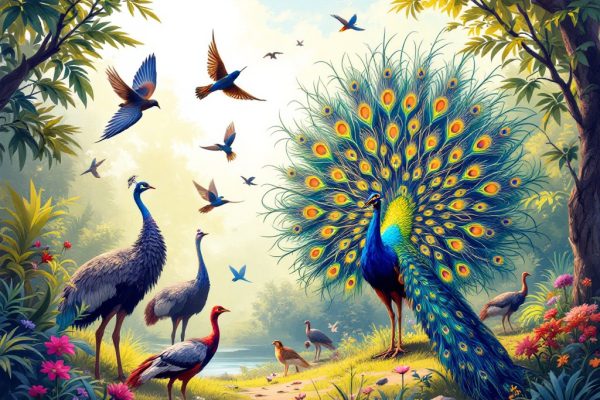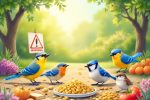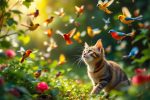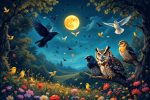Names Used to Describe a Group of Birds
Discover the fascinating world of collective nouns for birds! From a “murder” of crows to a “parliament” of owls, these unique terms reveal intriguing insights into bird behavior and social dynamics. Explore the origins and meanings of these descriptive names, enhancing your birdwatching experience and deepening your appreciation for the avian world. Dive into this rich vocabulary and unlock a new level of understanding about our feathered friends.
Important information
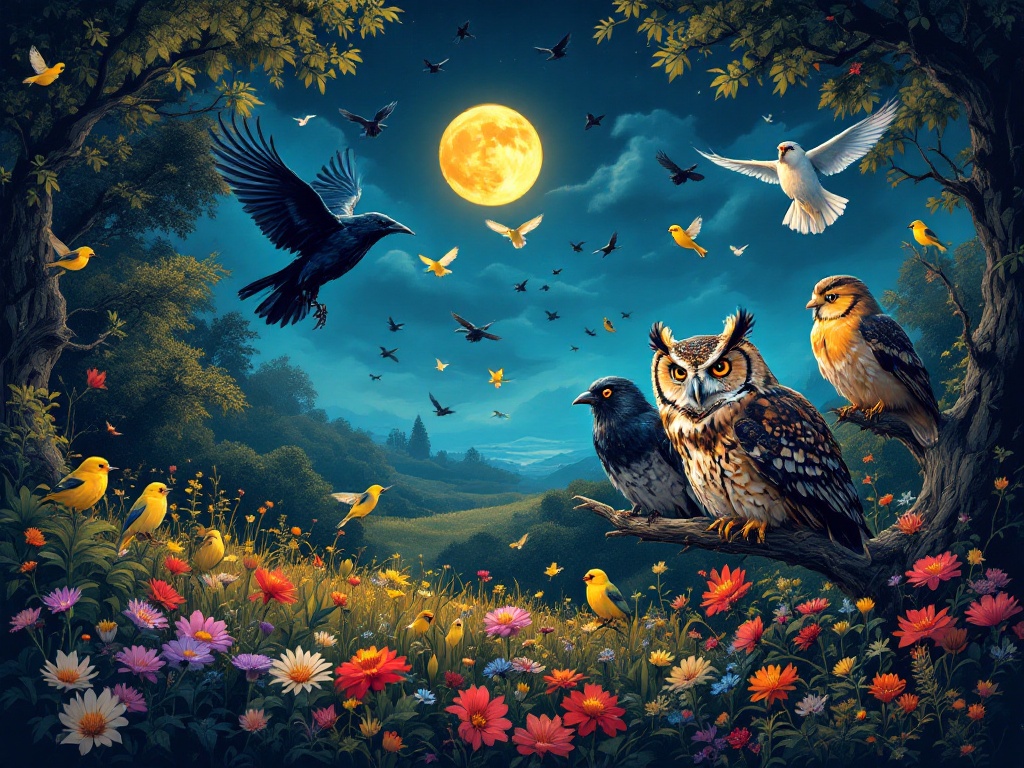
- Collective nouns describe groups of things, often animals, especially birds. Examples include a murder of crows or a parliament of owls.
- These terms often reflect the birds’ behavior or appearance. A “gaggle” of geese highlights their noise, while an “ostentation” of peacocks emphasizes their showy nature.
- The terms are useful for birdwatchers, enabling precise communication about sightings. A “kettle” of hawks describes their circling flight pattern, while a “murmuration” of starlings describes their synchronized movement.
- Some terms have roots in folklore. “Murder” of crows connects them to a dark reputation, while “parliament” of owls suggests wisdom.
- The same species can have different collective nouns depending on their location or activity. Geese are a “gaggle” on land but a “skein” in flight.
Introduction to Names Used to Describe a Group of Birds
Collective nouns for birds offer intriguing descriptions. For example, a “murder” of crows hints at their perceived darkness, while a “gaggle” of geese reflects their noisy nature. An owl “parliament” suggests wisdom. These terms enrich our language about birds and provide insights into their behavior and social dynamics.
Understanding Collective Nouns for Birds
Collective nouns for birds often reveal something about their nature. For instance, a “murder” of crows hints at their ominous reputation. Owls, known for wisdom, gather in a “parliament”. Geese, when walking, form a “gaggle”, but transform into a “skein” during flight. Hawks soaring together are a “kettle”, while the energetic songs of larks earn them the title of an “exaltation”. These descriptive terms enrich our language and allow birdwatchers to communicate with precision.
What Are Collective Nouns?
Collective nouns describe groups of things, often animals. Some examples include a murder of crows, a parliament of owls, and an exaltation of larks. These colorful terms, derived from observing animal behavior, enrich our language.
Importance of Collective Nouns in Birdwatching
Collective nouns for birds are essential for birdwatching, improving communication, and deepening our understanding of bird behavior and social structures. They enrich our observations and enhance our appreciation of avian diversity. For instance, a “murmuration” of starlings vividly describes their mesmerizing, synchronized flight. A “kettle” of hawks depicts their circling hunting patterns. Such precise terms allow birdwatchers to share vibrant descriptions of sightings, connecting enthusiasts to a larger community and the rich history of birdwatching.
Popular Names for Groups of Birds
Crows gather in murders, a name rooted in ancient folklore that associated these intelligent birds with death. Their loud calls and sometimes aggressive behavior only enhanced this dark reputation.
Owls assemble in parliaments, a name evoking their perceived wisdom and serious nature, suggesting a gathering of wise figures.
A group of finches is known as a charm, a word reflecting their vibrant plumage and delightful songs, capturing the joy they bring with their colorful feathers and cheerful melodies.
Geese congregate in gaggles on the ground. While the word’s origin remains uncertain, it possibly stems from an old Dutch term for “to cackle,” a fitting description for these noisy, social birds.
Starlings form mesmerizing murmurations, vast swirling flocks that twist and turn in the sky with remarkable coordination. This is a stunning aerial display of social behavior.
A Murder of Crows: Why This Term?
The term “murder” for a group of crows comes from ancient folklore that associated these black-feathered scavengers with death, giving them a dramatic collective noun. This somewhat ominous label reflects their sometimes unsettling presence. However, crows are remarkably intelligent, demonstrating an ability to use tools and solve problems. Their complex social structures further highlight their sophisticated nature. While the name “murder” may sound dark, it offers a captivating glimpse into the history of language.
A Gaggle of Geese: Exploring Its Origins
Geese on the ground are called a gaggle, likely due to their honking. In flight, however, they’re known as a skein.
A Parliament of Owls: The Story Behind the Name
Owls, when gathered, form a “parliament”. This name reflects their perceived wisdom and solemnity, much like a legislative body. The term’s origin is shrouded in mystery, yet its use is common.
A Murmuration of Starlings: What It Signifies
Starlings’ mesmerizing aerial displays, called murmurations, are a breathtaking sight, often seen at dusk as the birds gather for the night. Researchers believe these synchronized flights serve several purposes, primarily defense against predators like peregrine falcons. A large, swirling flock makes it difficult for a predator to target any single bird. The murmurations also help with communication, allowing the birds to share important information, such as the location of food sources.
A Charm of Finches: Understanding Its Meaning
A charm of finches, with their vibrant plumage and cheerful songs, brightens any natural setting. These small birds are a delight to observe, adding a touch of beauty to the landscape.
Names for Groups of Waterfowl
Spotting ducks on the water? That’s a raft. See geese on land? They’re a gaggle. Ducks dabbling in shallow water form a paddling.
See geese flying in their signature V formation? That’s a skein. These specific terms help us differentiate bird groups based on their activity and location.
A Raft of Ducks: More Than Just a Name
Ducks frequently gather on the water, creating formations called rafts. These rafts offer several advantages, including protection from predators, convenient access to food sources, and a setting for social interaction. Dabbling ducks like mallards, teals, and canvasbacks are commonly observed forming these rafts.
A Skein of Geese: How It Differs from a Gaggle
A skein of geese describes a flock in flight, often forming a characteristic V. Unlike a gaggle, which refers to geese on land or water, “skein” emphasizes their migratory journey and distinctive flight formation. This V-shaped arrangement enhances their flying efficiency and navigational skills.
A Paddling of Ducks: Unique Aspects
A paddling of ducks refers to a group of these waterfowl on the water, often seen dabbling or swimming. The term aptly describes their characteristic movement and aquatic habitat.
Unique Group Names for Predatory Birds
Eagles gather in a convocation, a fitting term for these majestic birds and their impressive assemblies.
Hawks form a kettle, circling together within rising air currents known as thermals to gain altitude.
Herons assemble in a siege, patiently waiting to ambush unsuspecting prey.
A Convocation of Eagles: Royalty in the Sky
A convocation of eagles perfectly captures their majestic presence and dominance as apex predators. These powerful hunters command the skies.
A Kettle of Hawks: Hunting in Groups
A kettle of hawks is a mesmerizing sight: a group of these raptors circling together, often while hunting or migrating. The swirling formation resembles a boiling kettle, giving the phenomenon its name. Hawks cleverly utilize rising warm air, called thermals, to gain altitude, conserving precious energy during their long journeys. This circling behavior is especially common during fall migration.
A Siege of Herons: Patience in Action
A “siege of herons” aptly describes a group of these birds, reflecting their distinctive hunting strategy. They stand motionless, waiting patiently, sometimes for extended periods, before ambushing their prey.
Colorful and Exotic Bird Group Names
Peacocks, with their dazzling iridescent plumage, gather in a fittingly named ostentation.
Flamingoes, a flamboyance, aptly reflect their vibrant pink hues and flocking behavior.
Parrots, known for their bright colors and sociability, are collectively called a company. These unique names vividly capture each bird’s distinct personality.
An Ostentation of Peacocks: Beauty in Numbers
Male peacocks are known for their vibrant, iridescent tail feathers, which they display in an elaborate courtship ritual to attract females. This impressive spectacle showcases the male’s beauty and dominance.
A Flamboyance of Flamingoes: A Splash of Color
A flamboyance—the name itself evokes the vibrant colors and social dynamism of a flock of flamingoes. These striking birds congregate in large numbers, creating a breathtaking spectacle of pink and orange.
A Company of Parrots: Vibrant and Social
Parrots, known for their vibrant plumage and sociability, gather in groups called companies. These intelligent birds engage in complex interactions, from playful antics and mutual preening to a chorus of calls. These social activities are essential to their well-being.
Intriguing and Less Common Group Names
Lapwings, known for their trickery and elusiveness, gather in a group called a “deceit”. Ravens, with their dark plumage and ominous reputation, are collectively called an “unkindness.” A “descent” of woodpeckers describes their downward foraging motion on tree trunks.
A Deceit of Lapwings: Mystery and Misconception
A “deceit” is the collective noun for a group of lapwings, a name reflecting their cunning nature. These masters of deception will lure predators away from their nests with elaborate, distracting displays to safeguard their young.
An Unkindness of Ravens: Understanding the Term
Ravens are often unfairly associated with unkindness, a reputation rooted in myths and legends that link them to ill omens and death. This negative perception is amplified by their dark plumage and the sinister roles they often play in stories, cementing their image as figures of darkness across many cultures. However, ravens are highly intelligent and social creatures known for their complex communication and problem-solving skills. They are devoted partners and parents, exhibiting remarkable loyalty and care within their family groups. Their resourcefulness and adaptability allow them to thrive in diverse environments, from rugged coastlines to bustling urban landscapes. Ravens are also fascinating subjects of scientific study, offering valuable insights into avian intelligence and social behavior. So, while their dark appearance and mythical associations might initially evoke unease, a closer look reveals a bird of remarkable intelligence, social complexity, and surprising beauty.
A Descent of Woodpeckers: A Unique Gathering
Woodpeckers, aptly named for their habit of spiraling down tree trunks, use this “descent” to locate insects and excavate nests. Their distinctive drumming, created by pecking at trees, serves the dual purpose of finding food and establishing nesting sites.
Comprehensive List of Bird Group Names
Bitterns are found in sedge marshes. Cranes can also be found in sedges, or in herds.
- Doves: doles, flights, piteousness.
- Chickens: broods, clutches, peeps.
- Cormorants: gulps.
Penguins are found in colonies, waddles, rookeries, or rafts. Quails gather in bevies, coveys, or drifts.
Bitterns: A Sedge
Bitterns thrive in sedge, a wetland vegetation offering superb camouflage and ideal nesting sites. This explains their collective noun: a sedge of bitterns.
Chickens: Brood, Clutch, Peep
A brood of chickens refers to a group of young chicks hatched together and nurtured by a hen. A clutch describes the set of eggs a hen lays at once, often incubated together. A “peep” specifically denotes newly hatched chicks, emphasizing their small stature and characteristic chirping. These terms represent various stages and facets of a chicken’s lifecycle.
Cormorants: A Gulp
Cormorants are known for swiftly gulping down fish whole, a behavior that inspired their name.
Crane: Herd or Sedge
Cranes are social birds, gathering in large groups called herds or sedges. The term “sedge” reflects their marshland habitat, where these plants thrive. “Herd” emphasizes their gregarious nature.
Doves: Dole, Flight, Piteousness
Doves, collectively known as a dole, are famous for their melancholic cooing that fills the air with mournful sounds. However, a flock in flight presents a striking contrast, revealing the birds’ graceful movements as they soar and dip with effortless elegance. The phrase “piteousness of doves” aptly describes their gentle, seemingly vulnerable nature, evoking feelings of sympathy and a desire to protect these innocent creatures.
Penguins: Colony, Waddle, Rookery, Raft
Penguins are known for their social nature. On land, they gather in groups called colonies or waddles, with breeding colonies specifically referred to as rookeries. At sea, penguins congregate in rafts for warmth and safety.
Quails: Bevy, Covey, Drift
Quails are social birds, forming groups called bevies, coveys, or drifts.
